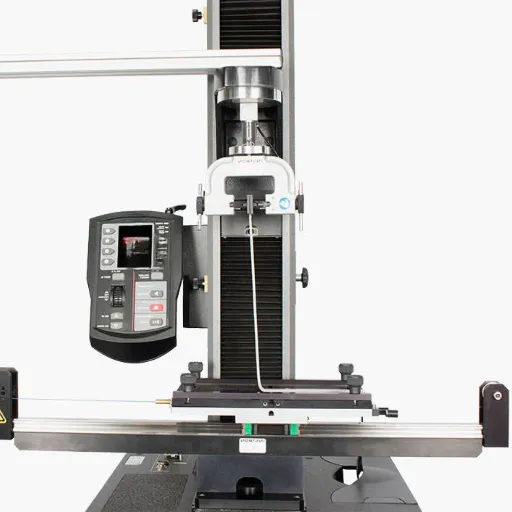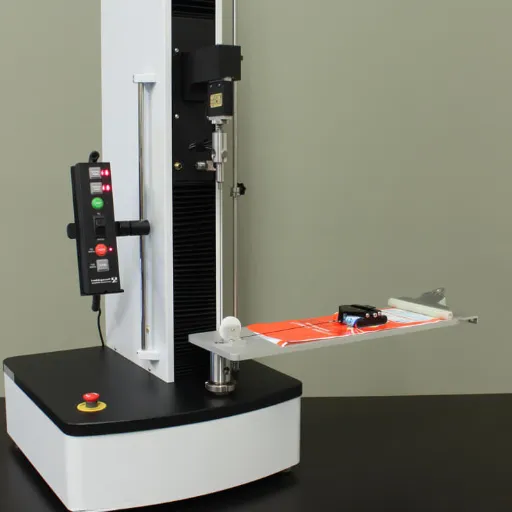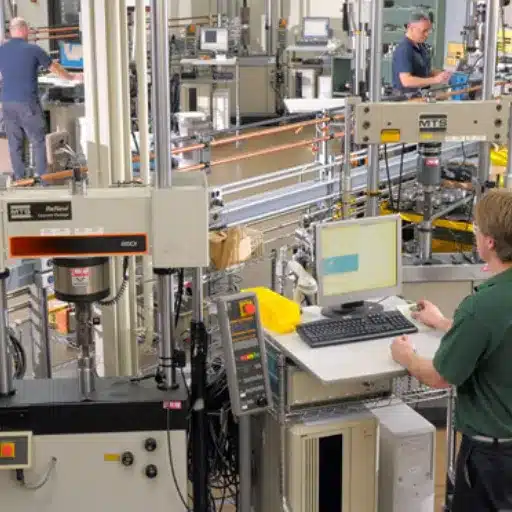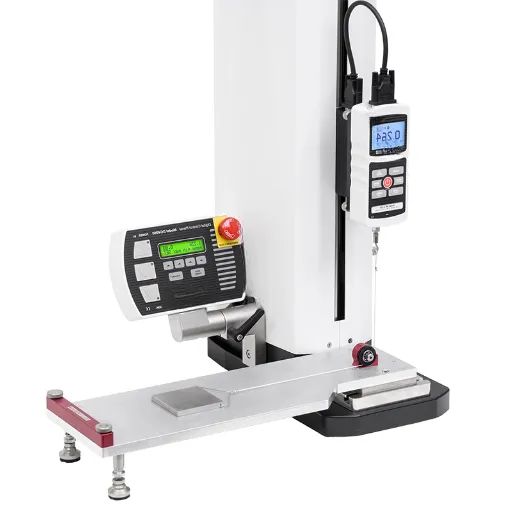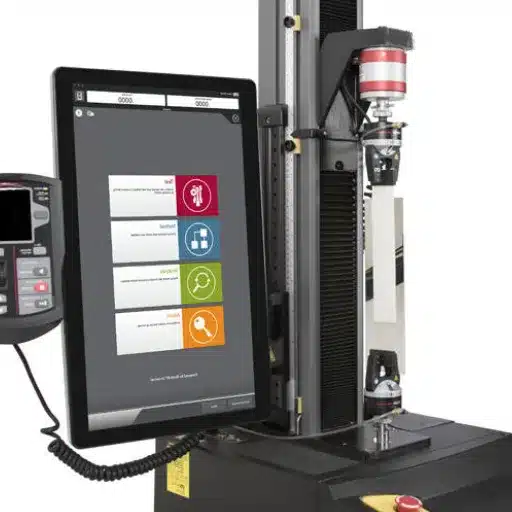Material selection and performance evaluation are key steps in the engineering, manufacturing, and design process. In the heart of this process is the tensile test: one of the most common mechanical tests to find out the strength, ductility, and elasticity of a material under tension. This article aims at sharing a thorough view of tensile testing, its utility in determining mechanical properties, and important standards that regulate its application. Whichever side you stand on-a practicing engineer striving to make an optimum use of materials or a researcher trying to develop new material compositions-an understanding of tensile testing is at the very root of reliability, efficiency, and safety in a myriad of industries. So, join us as we move along the science and methodology behind this crucial testing and highlight its impact in the real world.
Tensile Test Fundamentals
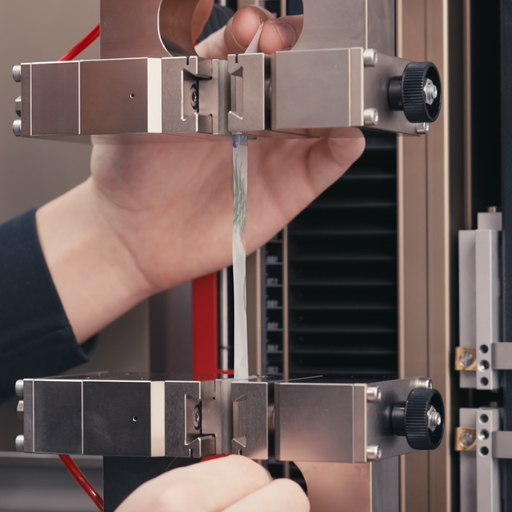
Basically, it is a tensile test for mechanical testing of materials to find mechanical strength and elasticity. The uniaxial tensile force is transmitted by the test on a sample until it breaks, while crucial properties are measured, such as ultimate tensile strength (the maximum stress a material can ever endure), yield strength (the stress at which the material stops being elastic), and elongation (how far a material can be stretched). This test is widely employed with standardized equipment and procedures to ensure reproducibility and reliability of the results. Such testing is vital in assessing material performance for manufacturing, construction, and product design.
What is a Tensile Test?
A tensile test is the fundamental mechanical test that determines how the material behaves under axis tensile loading. The process involves a sample prepared according to a specific standard dimensional specification usually given by international accreditation organizations such as ASTM or ISO subjected to a controlled uniaxial force until it breaks. This test measures key parameters such as tensile strength, yield strength, elongation, and modulus of elasticity to allow for a detailed view of the material’s mechanical behavior. Data derived from tensile tests are crucial in determining the suitability of materials for structural, industrial, and engineering applications. From the latter studies and trends, the newer innovations involve the use of advanced sensors and digital imaging techniques to record data accurately and provide a sophisticated way of strain analysis further guaranteeing the reliability of the results for modern evaluation of material.
Importance of Tensile Testing
The tensile test provides a lot of information about the nature of the mechanical behavior of a material under stress.It tells about its strength, ductility, and elasticity.In knowing this behavior of the material, it could be decided whether or not the material can withstand the service demand of a given application without failing.Tensile testing incorporates digital imaging in strain analysis techniques, which provides precise data needed by an engineer in selecting materials that meet safety standards and optimum performance in major industries such as aerospace, construction, and manufacturing.
Basic Principles of Tensile Testing
The principle of tensile testing is the application of controlled force to a sample until deformation ensues to determine the material’s mechanical properties, principally tensile strength, elasticity, and ductility. The sample requiring testing is gripped in grips in the universal testing machine (UTM) to apply elongation forces gradually until failure. During the test, stress (force per unit area) and strain (relative deformation) are measured by sensors, allowing an eminent realm of information in the form of a stress-strain diagram, representing behavior of material under loading.
The key parameters yielded by the tensile testing are the ultimate tensile strength (maximum stress that a material can withstand), yield strength (stress at the onset of material plastic deformation), and modulus of elasticity (stiffness of material). The above data is used for the selection of materials for engineering applications with respect to various standards in design so that the material may be reliable for the working conditions.
Tensile Properties of Materials
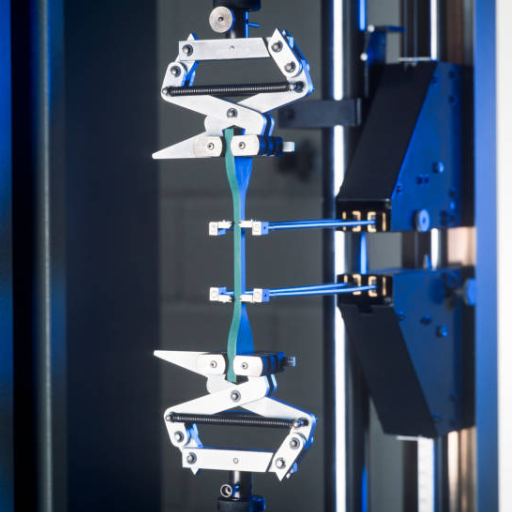
Tensile characteristics explain how a material behaves mechanically under unidirectional tensile forces. Some major parameters include:
1.Ultimate Tensile Strength: Related to the maximum intensity of stress a material can take before failure.
2.Yield Strength: Which defines the change from elastic deformation into plastic deformation.
3.Modulus of Elasticity: Which is a measure of stiffness of the material, the slope on a stress-strain curve in the elastic region.
They are determined from a standardized tensile test; these properties serve as primary factors in the design process of engineering so that materials may perform and act accordingly under given conditions and safely.
Strength, Ductility, and Elasticity
Strength is the attribute that enables a material to resist loads without failure. Tensile strength, compressive strength, and shear strength are calculated to specify the maximum stresses that can be applied to a material under different conditions.
Ductility defines the material’s ability to undergo plastic deformation before failure. Highly ductile materials like metals, copper, or aluminium undergo large elongations or bending without failure and are considered for shaping requiring extensive deformation processes.
Elasticity means the capacity of a material to restore its original dimension and shape after removal of deformations caused by stress, so long as it has not exceeded the elastic limit. Such a characteristic is required in materials because they must sustain repeated loading, e.g., springs or structural members under cyclic stress.
Being closely associated developments, their considerations for engineering materials form a basis for performance under specific mechanical requirements and the assurance of reliability in practical application.
Factors Influencing Tensile Properties
1.Material Composition
Tensile properties are highly dependent on the chemical constitution of a material. The strength, ductility, and resistance to deformation of any material are determined by alloying elements, impurities, and microstructural phases.
2.Heat Treatment and Processing
Annealing, quenching, tempering, and several other heat treatments alter the fine structure of the material along grain coarsening, dislocation densities, and phase affinity, thereby altering tensile behavior.
3.Grain Structure
The size, geometry, and orientation of grains in materials correlate directly with their ability to endure stress. A fine grain material usually provides greater strength because it resists slip and dislocation movement.
4.Load Application
The rate of stress application, the synthesizing force relative to the surface geometry, and the duration of such stress are all factors that significantly determine tensile properties. The properties may differ when a material is subjected to static loading, dynamic loading, or cyclic loading.
5.Environmental Conditions
High temperatures accompanied by humidity and corrosive agents constitute grave factors in the degradation of tensile properties. High temperatures may drastically reduce strength while increasing ductility; corrosion, on the other hand, tends to gradually disintegrate the structural integrity of materials.
Comparison of Different Materials
The materials to be compared include steel, aluminum, titanium, composites, and polymers.
|
Material |
Strength |
Weight |
Ductility |
Corrosion |
Cost |
|---|---|---|---|---|---|
|
Steel |
High |
High |
Moderate |
Moderate |
Low |
|
Aluminum |
Moderate |
Low |
High |
Low |
Moderate |
|
Titanium |
High |
Low |
Moderate |
High |
High |
|
Composites |
High |
Very Low |
Low |
High |
Very High |
|
Polymers |
Low |
Very Low |
High |
Low |
Low |
Tensile Testing Machines and Equipment
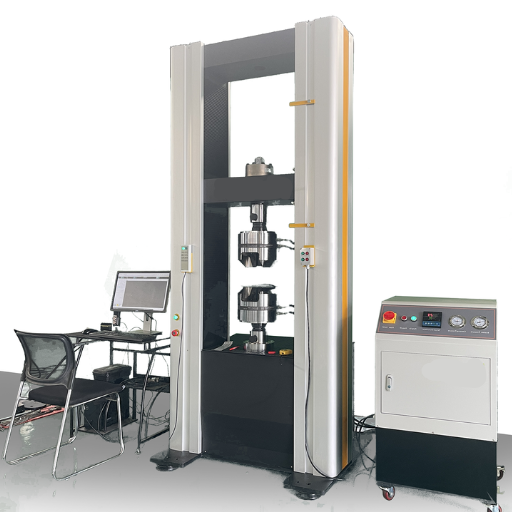
In the tensile testing machine, material properties are accurately quantified under a uniaxial tension condition. The major components of the tensile testing machine include: load frame, grips to hold the specimen, load cell for force measurement, and extensometers for extension measurement. Depending upon the material being tested such as steel, aluminum, or polymers, particular configurations and equipment may be used. Maximum loading capacity, type of control system used (e.g., hydraulic, electromechanical), alignment method, etc., are among important parameters considered while testing various materials of different strengths and deformability.
Types of Testing Machines
Tensile testing machines can be categorized into universal testing machines, single-column testers, dual-column testers, and horizontal tensile machines.
|
Type |
Key Feature |
Capacity |
System |
Main Use |
|---|---|---|---|---|
|
Universal Testing |
Versatile |
High |
Hydraulic/Electro |
Multiple materials |
|
Single-Column Tester |
Compact |
Low |
Electromechanical |
Lightweight materials |
|
Dual-Column Tester |
Stable |
Medium-High |
Electromechanical |
Medium loads |
|
Horizontal Tensile |
Long samples |
Variable |
Hydraulic/Electro |
Cables, rods |
Components of a Tensile Testing Machine
A tensile testing machine consists of several critical components that ensure the delivery of precise testing outcomes consistently:
1.Load Frame – The primary structural support, providing stability during testing. It typically includes a base, vertical columns, and a traversing crosshead.
2.Load Cell – This sensitive sensor accurately measures the force exerted on the specimen.
3.Grips/Fixture – The specimens are held between two grips. Various types of grips-wedge, pneumatic, or mechanical-are selected based on the material and test requirements.
4.Drive System – It applies controlled motion to the crosshead via electromechanical or hydraulic means, depending on the system type.
5.Control System– This is the interface for configuring test parameters, such as the load to be applied or crosshead speed, as well as performing the data acquisition via specialized software.
6.Extensometer- An optional but very important instrument used to record the actual elongation of the specimen during the test.
7.Data Acquisition System- Records and processes the data coming from the load cell and extensometer, providing reports containing the values for tensile strength, elongation, and other vital properties of the material.
Together, all these components work harmoniously toward making tensile testing machines fulfil the challenges placed before them by material testing in varied sectors, providing utmost reliability and accuracy.
Selection Criteria for Test Equipment
Test equipment selection criteria are laid down, considering their performance in servicing the job. Thus, first is the check on accuracy and precision since they determine data to be reliable and reproducible. Second is the compatibility of the machine with the materials and specimen sizes I work with, with regard to the range of test conditions to be applied. Third, I check for software and data acquisition capabilities, with the main criteria being ease of use, advanced reporting features, and ability to integrate with other systems that I have. Lastly, I consider durability and maintenance requirements, as I choose only those that have long-term stability with low-maintenance requirements. In other words, considering these points ensures that the selection of test equipment will result in one that serves efficiently for both present and future testing requirements.
Standards and Procedures in Tensile Testing
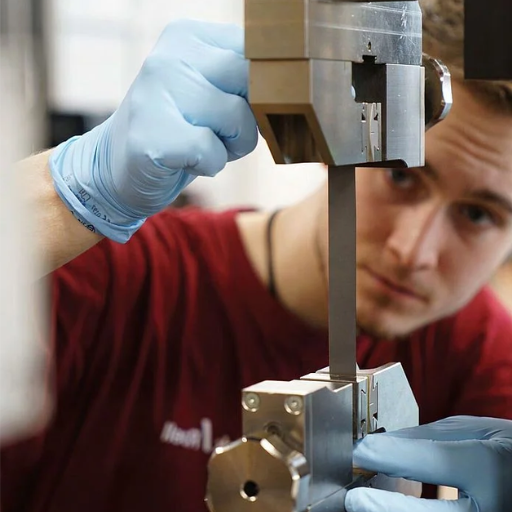
The tensile testing follows the standard methods developed by ASTM (American Society for Testing and Materials) or ISO (International Organization for Standardization). For example, ASTM E8/E8M and ISO 6892 are common standards that dictate how to prepare a specimen, testing conditions, and reporting of data. They keep results consistent and comparable across different laboratories and industries.
Testing will usually start by preparing a test specimen of precise dimensions. Placing it in the testing machine would be the next step, wherein a tensile force is applied in a controlled way. Very important key parameters to keep in mind are the rates of strain and alignment of grips, otherwise results would be compromised. Data regarding stress, strain, and elongation are thus recorded and further used for determining material properties such as yield strength, ultimate tensile strength, and ductility. The consideration of these standards and working procedures would ensure accurate and reproducible assessments of material performances.
Overview of ASTM and ISO Guidelines
ASTM and ISO standards are given to the world to ensure the testing and evaluation of materials are consistent and to guarantee reliability. ASTM, an acronym for the American Society for Testing and Materials, works towards the establishment of voluntary consensus standards for various industries including metals, plastics, and construction materials. With respect to tensile testing, ASTM E8/E8M lays down methods of testing metallic materials in tension to evaluate their mechanical properties.
ISO, on the contrary, stands for the International Organization for Standardization. This is an internationally recognized entity that develops harmonized standards aimed at facilitating worldwide trade and interoperability. ISO 6892 is the principal standard for metallic materials tensile testing, providing largely similar methods and procedures as ASTM E8 but with emphasis placed on harmonizing on an international basis. While both organizations aim to standardize testing procedures, as far as differences are concerned, ASTM mainly deals with standards on a US-sized area, whereas ISO concerns with an international arena. Hence, laboratories must mainly look at ASTM or ISO standards depending on which they are instructed to do so or for what their clients specify.
Preparation of Tensile Specimens
The preparation of tensile specimens is a key step toward obtaining accurate and reproducible results in tensile testing. The specimens are usually machined to exact dimensions as specified in the appropriate specifications, such as in ISO 6892 or ASTM E8. The common shapes of specimens are dog-bone, round, and flat, whereas the shape to be chosen depends on the material and test requirements. The edges of the specimen must be smooth and free from any defects that could cause a stress concentration leading to premature failure during the test. Furthermore, one needs to ensure that the surface finish is applied uniformly. The application of surface finish may be accomplished by grinding or polishing to minimize any irregularities that could affect mechanical properties measurement. Being within the tolerances indicated in the relevant standard is essential for meaningful data to be reliably compared in other tests in another laboratory.
Step-by-Step Testing Procedure
- Specimen Preparation
a. Machine the test specimen to the required dimensions as per the relevant standard.
b. Inspect the specimen for surface defects or irregularities, ensuring no stress risers are present.
c. Apply surface finishing techniques, such as grinding or polishing, to achieve consistent surface quality.
d. Verify the final dimensions and tolerances using precise measurement tools.
- Test Setup
a. Calibrate the testing machine according to the manufacturer’s specifications and the applicable standard.
b. Secure the specimen in the testing apparatus, ensuring proper alignment to avoid eccentric loading.
c. Configure the test parameters, including load rate, temperature, and environmental conditions as required by the standard.
- Pre-Test Checks
a. Confirm the accuracy of all sensors and data acquisition systems.
b. Ensure environmental conditions in the testing area meet the specified requirements, such as temperature and humidity control.
c. Validate that the safety protocols are in place, and inspect all equipment to prevent unexpected failures.
- Execution of the Test
a. Start the test while maintaining the specified loading or displacement rate.
b. Monitor real-time data acquisition, ensuring the system is properly recording force, displacement, or strain values.
c. Observe for any unusual behavior or indications of specimen failure.
- Post-Test Analysis
a. Carefully remove the specimen and inspect it for fracture or deformation characteristics.
b. Record the failure mode and measure post-test dimensions if applicable.
c. Compile and process the raw data using appropriate analysis techniques.
d. Compare results to established benchmarks or standards for validation.
- Documentation and Reporting
a. Prepare a detailed test report, including all relevant parameters, data, and observations.
b. Include photographs or diagrams documenting the specimen and test setup.
c. Discuss possible sources of error and ensure compliance with the chosen standard.
d. Archive all data and reports securely for reference or future analysis.
Applications of Tensile Testing Across Industries
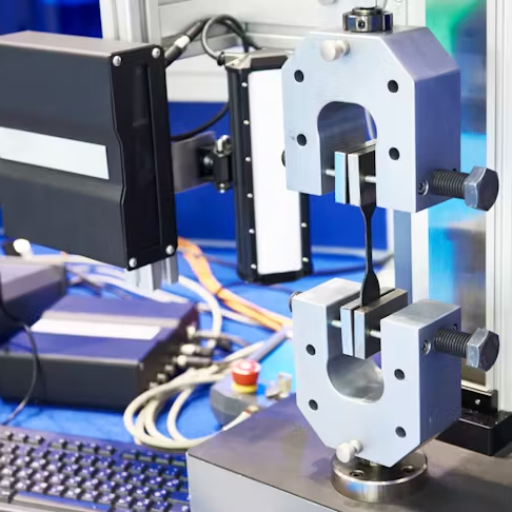
Tensile testing plays an important function in countless industries, wherein materials and their mechanical properties under stress are analyzed. In automotive and aerospace industries, tensile testing ensures that materials like metals and composites will make the structural components durable and safe. In construction, tensile testing evaluates the strength of steel, reinforcing materials for concrete, and other materials required for infrastructural stability. In polymers and plastics manufacture, tensile testing analyses are useful for determining the elasticity, yield strength, and elongation properties of materials, thereby deciding which materials are suitable for different purposes. These tests help to meet stringent requirements, develop quality assurance schemes, and encourage innovation in the development of materials.
Tensile Testing in Aerospace
In the aerospace industry, tensile testing appears to be very serious and important since the materials in the aerospace industry are subjected to high stress levels and environmental conditions. By testing aerospace fine metals, alloys, and composites for tensile and yield strength and for elongation limits, engineers ensure that the components withstand enormous forces exerted during taking off and re-entry. Such advanced materials, be they titanium alloy or carbon-fiber composites, undergo tensile testing in a very rigorous manner so as to assure weight elimination and corrosion resistance to some degree without compromising structural integrity. The aerospace components will then ensure that all their activities from airframes to propulsion systems meet the requirements of the industry performance standards like ASTM E8/E8M and ISO 6892 for their safety, durability, and reliability.
Importance in Automotive Manufacturing
Advanced materials are fundamental in auto manufacturing as they allow lighter, stronger, and hence more fuel-efficient automobiles to be built. Materials like high-strength steel, aluminum alloys, and carbon-fiber composites are thus commonly employed in the automotive industry to reduce vehicle weight without compromising its crashworthiness, energy efficiency, emission standards, etc. Besides, material technology advancement, such as advanced polymers or nanocomposites, enables the design of components with better durability and corrosion resistance, which basically matches the industry goals of sustainability and cost-efficiency.
Construction and Material Safety
Construction and material safety aim to guarantee life safety, structural integrity, durability, and compliance with stringent safety standards. Material developments, including high-performance concrete, steel reinforcements, and engineered wood products, apply to buildings that maintain their safety under extreme conditions. Equally important is the incorporation of fire-resistant materials, seismic reinforcements, and advanced inspection technologies that work together to lessen the level of risk carried by a construction project. These relate to contemporary codes and sustainability objectives that speak to the concept of life-cycle performance, minimal operational hazards, and protection of the occupants at large.
Reference Sources
-
ASTM E8: Standard & specimens for metals tensile test – This source provides details on the ASTM E8/E8M standard for uniaxial tensile testing of metals at room temperature.
-
8 Most Common ASTM Standards in Tensile Testing – A comprehensive overview of the most influential ASTM standards in tensile testing.
-
ASTM Tensile Testing Standards for Determining Material Properties – Discusses ASTM E8/E8M and other standards like ASTM A370 for evaluating materials under tension.
-
ASTM D638: The Definitive Guide To Plastic Tensile Testing – Focuses on ASTM D638, the standard for tensile testing of plastics.
-
ASTM Standards for Tensile Testing – Covers various ASTM standards, including ASTM D3039 for polymer matrix composites and ASTM E8/E8M for metals.
Frequently Asked Questions (FAQ)
Q:What is a tensile test and why is it important in materials science and engineering?
A:A tensile test, also known as a tension test, is a mechanical test that measures the response of a material when subjected to uniaxial tension. This test is crucial as it provides valuable data on the mechanical properties of materials, such as yield strength, tensile strength, and elongation. Understanding these properties helps engineers and scientists select appropriate materials for various applications, ensuring safety and performance in engineering designs.
Q:How is a tensile specimen prepared for testing?
A:Preparing a tensile specimen involves cutting the material into standardized shapes and dimensions as specified in test standards. The specimen typically has a uniform cross-sectional area to ensure accurate measurements. Factors like the length of the specimen and the cross-sectional area of the specimen are critical for consistent results, as they influence the applied force and the material’s response during the test.
Q:What equipment is used in a tensile test machine?
A:A tensile testing machine, also referred to as a test machine, is equipped with various components, including grips to hold the specimen, a load cell to measure the applied force, and an extensometer to measure elongation. These machines can vary in design and capabilities, accommodating different tensile testing applications and providing data on tensile properties under various conditions.
Q:What are the typical tensile properties measured during tensile testing of metals?
A:The tensile properties measured during tensile testing of metals include yield strength, ultimate tensile strength, elongation, and reduction in area. These properties give insight into a material’s ductility and brittleness, helping to predict how it will behave under different stresses and strains. The strength and modulus of the material are critical parameters that inform engineers about its suitability for specific applications.
Q:What is the significance of the yield point in a tensile test?
A:The yield point in a tensile test is the stress at which a material begins to deform plastically. Beyond this point, the material will not return to its original shape, leading to permanent deformation. Understanding the yield strength of the material is essential for engineers to ensure that components operate within safe limits under applied forces, preventing structural failure.
Q:How does test speed affect the results of a tensile test?
A:Test speed, or the rate at which the load is applied during a tensile test, can significantly influence the results. Different materials respond differently to various test speeds, with some showing increased strength at higher speeds and others becoming more ductile. This variability necessitates standardized test speeds to ensure consistent and comparable test data across materials.
Q:What are some common testing applications of tensile tests?
A:Tensile tests are widely used in various industries, including construction, automotive, and aerospace, to evaluate the mechanical properties of metals and composites. Applications range from quality control in manufacturing to research and development in materials science and engineering. Knowing the tensile results helps in designing safer and more efficient structures and components.
Q:What does elongation and reduction in area indicate in tensile testing?
A:Elongation is the measure of how much a material can stretch before breaking, while reduction in area refers to the decrease in cross-sectional area of the specimen at the fracture point. These metrics indicate the ductility of the material. A high elongation and significant reduction in area suggest that the material can absorb considerable energy before failure, making it suitable for applications requiring flexibility and resilience.
Q:What factors influence the tensile modulus of a material?
A:The tensile modulus, or Young’s modulus, is influenced by the material’s composition, structure, and temperature during testing. It defines the relationship between stress and strain in the elastic region of the tensile curve. Higher tensile modulus values indicate stiffer materials, essential for applications where rigidity is required. Understanding these factors helps engineers select the right materials for specific uses.

